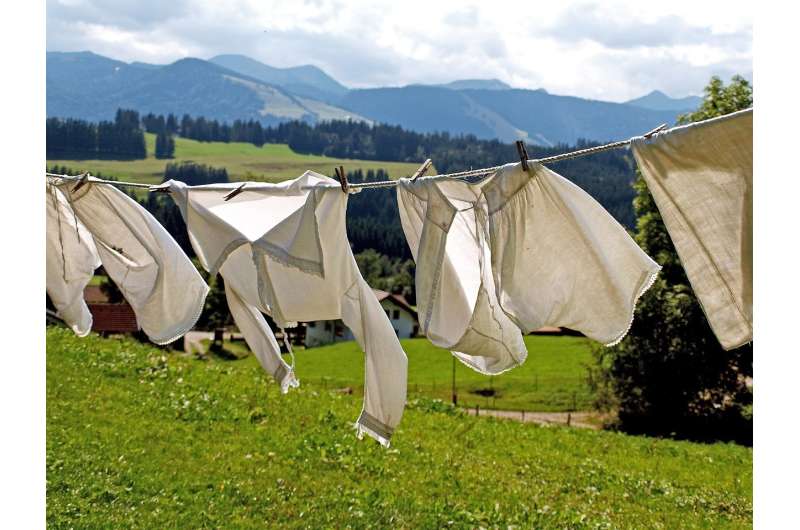Eco detergents – for greener whites in the airing cupboard

'Clean' and 'soft' are words strongly associated with washing products and fabric softeners, and soon they are set to be described as 'green' too with less chemical waste and longer-lasting action.
Of all modern conveniences, the humble washing machine is perhaps the greatest labour-saving device. Hours of dunking, scrubbing and wringing wet clothes are reduced to the mere act of stuffing soiled clothing into a cylinder and pressing the start button. The latest machines can even detect the weight of the laundry and release the correct dose of detergent into the wash cycle.
The typical European household washes clothes 365 times a year, according to the Netherlands' National Institute for Public Health and the Environment. In its cleaning products fact sheet, it states that people are exposed to fabric softener and cleaning products when handling wet laundry and again when wearing the washed clothes.
Most of the chemicals in washing detergents are drained away by the end of the wash, leaving a residual amount on the clothes. Yet an adult could be wearing clothes containing significant residues of cleaning products, a small amount of which (around 10%) is known to leach into the wearer's skin. Estimating the exposure to residual chemicals is important because cleaning and fabric softener products can contain toxic or harmful substances.
Enzymes
One possible future for clothes washing is enzyme-only products, using no additional detergent. Enzymes act as catalysts to speed up biochemical reactions, and detergents that contain them are marked as 'biological'. Enzymes are biodegradable, environmentally-friendly and can be reused. As things stand, enzymes that could be reused are flushed away with waste water.
After the detergent has done its job, the challenge is to remove the enzymes from the waste water for their re-use. Enzyme recollection tests carried out by Estonian start-up, ReLaDe, indicate that, for a typical household, one load of biological enzyme laundry agent could last 12 months. This is possible by using magnetic iron nanoparticles combined with the enzymes.
With research supported by the EU, ReLaDe is actively looking for commercial partners to bring its technology to market, which might also involve a design change to washing machines. Instead of having a dispenser that a detergent and softener are poured into, ReLaDe envisages a cartridge system of laundry detergent that contains the magnetic enzymes and would last for 12 months.
Business development manager for ReLaDe, Andrew Wilfong, said: 'You would buy a washing machine and once a year, you would exchange your cartridge for a new one.'
Another green advantage with the magnetic enzyme, ReLaDe says, is that the grey water produced by a washing machine, would not have to be treated at the local sewage plant. With magnetic enzymes, the waste water is still grey water and undrinkable, but Wilfong points out that it can be poured on to the garden because it does not contain any toxic detergent.
Reducing toxicity
Fabric softeners may also be improved and become biodegradable through the development of microencapsulation, whereby a liquid fabric softener is suspended in what is called a polymeric coating. Currently under development by the Barcelona-based Carinsa Group in a project called Eco-soft, the biodegradable coating allows for the use of less softeners, reducing toxicity while delivering cost savings and improved performance.
The eco-friendly polymeric coating would also replace existing encapsulation technologies that include the use of formaldehyde. 'In the capsules we can find on the market, they are made with products that are toxic to humans. One of them, the most-used system, (is) with formaldehyde,' said Carinsa's technical director, Cristóbal Bernal. 'It's a well-known carcinogen that is used in some softeners on the market. It's not dangerous to the population because the dosage is low.' But authorities still want to substitute it for safer chemicals. A recent report by the European Chemicals Agency proposed a strategy for the future restriction of formaldehyde and replacing it with a non-toxic alternative.
Microencapsulation will enable a dramatic decrease in the amounts of softener needed to do laundry, according to Carinsa, because up to 10 times more product will stay on the clothing during the washing process. CARINCAP microencapsulation is expected to be used commercially by softener products by the end of 2019.
The future of laundry will still involve stuffing soiled garments into a cylinder, but the grey water will be less toxic, can be used to water the garden, and laundered clothes will be soft and fragrant for much longer.
Provided by Horizon: The EU Research & Innovation Magazine

















